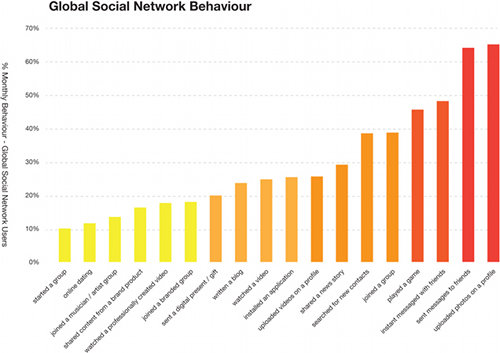World map of global social media usage
Tom Smith, founder of Trendstream, the company behind the GlobalWebIndex, exclusively talks us through their latest world map of global social media usage.
Click on the bottom right of the toolbar above to view full-screen or download the PDF version.
The new GlobalWebIndex Social Networking Map 2011 is designed to give a quick look overview at the state of social networking around the world. Some interesting trends are immediately visible that separate emerging market consumer from advanced market consumers.

Emerging market consumers are more highly engaged with their social networks with more social networkers actively messaging friends, sharing content, and getting involved in groups. While social networking often has similar penetration among Internet users in advanced markets, social networkers are more likely to be segmented in terms of their activities. In the USA, Canada, Japan, South Korea and EU countries, social networkers are most likely to belong to either messengers or content sharers, but not both. Group involvement in these markets is often a smaller subset of either of these two segments, and social networkers involved in group almost always belong to another segment as well.

In general, the results are counterintuitive in the way that social networkers are segmented. General wisdom would suggest that the primary motivation for joining a social network is to stay in touch with friends and that is indeed the main reason for most people to join a social network worldwide according to GlobalWebIndex data. Social networkers’ actions, however, suggest that actual behaviour is different from original intention, and in many markets, those that only share content often outnumber those using social networks to connect with friends. This, often separate, content distribution aspect of social networks requires to thinking in terms of engaging content sharers on social networks.
Another interesting insight that comes out of the map is how social networking activity seems to be platform agnostic, meaning that people on Facebook in the Philippines, Orkut in India, and Qzone in China all have similar social network behaviour despite the fact that the most popular social network in each market is different. This presents another challenge for brands developing global social strategies that require in depth market level analysis.
We actively explore the depth of GlobalWebIndex data to understand why social networking behaviour varies so much across markets, but what is clear from the map is that there is no silver bullet to targeting social networkers at a global level (and there are a lot as we can see). Building an effective social strategy or campaign, determining where your target consumers are online, and getting products in the hands of influencers requires detailed knowledge of not just how many people are doing what or what they are saying but who they are, why the undertake their chosen social activities and not others, and the most effective methods to engage a given subset of social networkers.